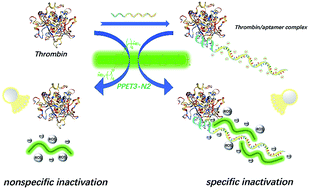当前位置:
X-MOL 学术
›
Anal. Methods
›
论文详情
Our official English website, www.x-mol.net, welcomes your feedback! (Note: you will need to create a separate account there.)
Conjugated polyelectrolytes with a label-free aptamer for specific protein photoinactivation†
Analytical Methods ( IF 3.1 ) Pub Date : 2018-03-28 00:00:00 , DOI: 10.1039/c8ay00272j Wei Fang 1, 2, 3, 4, 5 , Shuwen Liu 1, 2, 3, 4, 5 , Chunyan Tan 1, 2, 3, 4, 5 , Anqi Li 1, 2, 3, 4, 5 , Ying Tan 1, 2, 3, 4, 5 , Yuyang Jiang 2, 5, 6, 7, 8
Analytical Methods ( IF 3.1 ) Pub Date : 2018-03-28 00:00:00 , DOI: 10.1039/c8ay00272j Wei Fang 1, 2, 3, 4, 5 , Shuwen Liu 1, 2, 3, 4, 5 , Chunyan Tan 1, 2, 3, 4, 5 , Anqi Li 1, 2, 3, 4, 5 , Ying Tan 1, 2, 3, 4, 5 , Yuyang Jiang 2, 5, 6, 7, 8
Affiliation

|
Chromophore-assisted light inactivation (CALI) is a significant technique to realize knockdown or loss-of-function of target protein molecules in a spatiotemporally regulated manner. Based on the advantages of CALI, we hybridized PPET3-N2, a well-studied cation conjugated polyelectrolyte (CP), with a label-free DNA containing aptamer via electronic and hydrophobic interactions to produce reactive oxygen species (ROS) under light irradiation, which resulted in specific inactivation of the protein of interest, thrombin. The aptamer introduced into the system formed a complex with thrombin, whereby the aptamer decreased the distance between the PPET3-N2/DNA hybrid and thrombin. This proposed strategy efficiently inactivated thrombin with good specificity and provides a novel and universal approach for controlled inactivation of biomolecules.
中文翻译:

共轭聚电解质与无标记适体的结合,用于特定蛋白质的光灭活†
发色团辅助的光灭活(CALI)是一项重要技术,可以以时空调节的方式实现目标蛋白分子的敲低或功能丧失。基于CALI的优势,我们将PPET3-N2(一种经过充分研究的阳离子共轭聚电解质(CP))与不含标记的含有适体的DNA杂交,通过电子和疏水相互作用在光照射下产生活性氧(ROS),从而导致目标蛋白凝血酶特异性失活。引入系统的适体与凝血酶形成复合物,从而使适体减少了PPET3-N2 / DNA杂交体与凝血酶之间的距离。该提议的策略有效地以良好的特异性灭活了凝血酶,并为控制生物分子的灭活提供了一种新颖而通用的方法。
更新日期:2018-03-28
中文翻译:

共轭聚电解质与无标记适体的结合,用于特定蛋白质的光灭活†
发色团辅助的光灭活(CALI)是一项重要技术,可以以时空调节的方式实现目标蛋白分子的敲低或功能丧失。基于CALI的优势,我们将PPET3-N2(一种经过充分研究的阳离子共轭聚电解质(CP))与不含标记的含有适体的DNA杂交,通过电子和疏水相互作用在光照射下产生活性氧(ROS),从而导致目标蛋白凝血酶特异性失活。引入系统的适体与凝血酶形成复合物,从而使适体减少了PPET3-N2 / DNA杂交体与凝血酶之间的距离。该提议的策略有效地以良好的特异性灭活了凝血酶,并为控制生物分子的灭活提供了一种新颖而通用的方法。


























 京公网安备 11010802027423号
京公网安备 11010802027423号